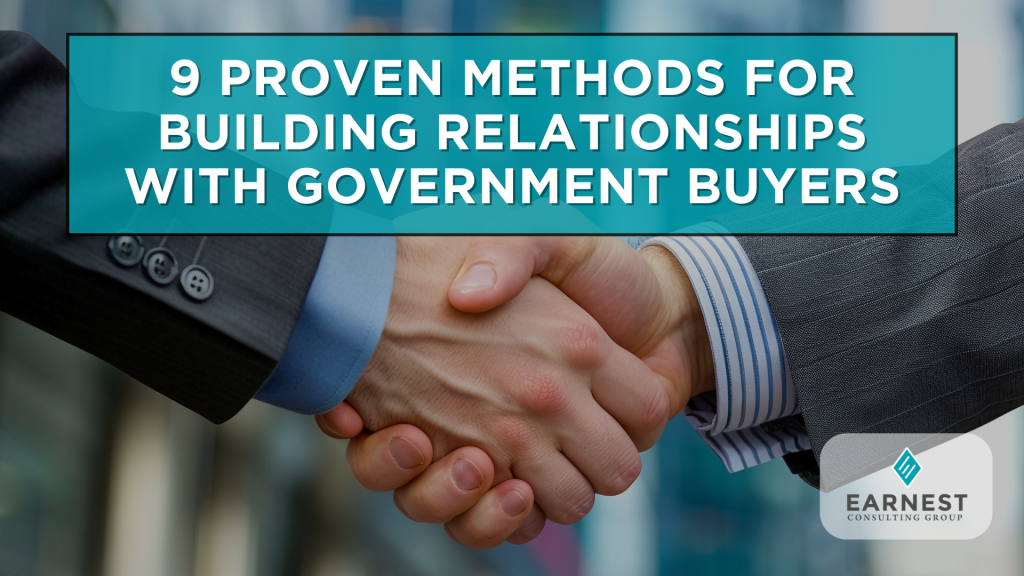9 Proven Methods for Building Relationships with Government Buyers
April 16, 2025 | Government
In government sales, building relationships isn’t just about getting in front of a contracting officer—it’s about connecting with all the key players involved in the buying process. When we say “government buyers,” we’re talking about a wider group: contracting officers, program managers, department heads, and even end users. Each plays a role in shaping how a purchase happens—and whether it happens with you.
Below are nine proven methods we’ve used—and coached hundreds of businesses through—to start and sustain meaningful buyer relationships in the federal market.
1. Use LinkedIn to Start the Conversation
Before you ever send that email or pick up the phone, make sure you’ve done the easiest thing: connect with them on LinkedIn. Follow the agency, like their posts, and drop a thoughtful comment now and then. This small effort shows up in their notifications and builds familiarity without asking for anything. It’s a light touch that warms up the relationship—and when you finally reach out, you’re not a stranger.
2. Be Direct in Your Outreach
Government buyers are busy. You only have six seconds. Make sure you provide one (only one) sentence communicating the value of your company using quantifiable/qualifiable metrics.
If you’re requesting a capabilities brief, ask for a date and time. “Lets schedule a capabilities brief. How about 2:00 PM on April 30th?” works better than “let me know if you’re available,” or “when it’s convenient for you.” Directness gets responses. Vague language gets ignored. Ask for only 15 minutes. Most will still give you 30 but be ready to accomplish your objectives in 15.
Also, propose times that are at least three weeks out. They are less likely to refuse. How many of us absolutely know we’ll be too busy three weeks from now?
3. Use One Clear Question to Start Dialogue
If you want to ask a question in your email, make sure it’s one you couldn’t find the answer to on your own. And only ask one. The right question—about procurement methods, agency needs, or upcoming initiatives—can be enough to start a dialogue. But a laundry list? That ends up in the trash folder.
4. Prioritize Learning Over Pitching
Instead of rushing into what you sell, slow down and learn what they’re dealing with. Ask about their challenges. Learn what matters to them and what’s on their plate. When you do that, you’re not just building rapport—you’re positioning yourself as someone who listens before offering a solution. You’d be surprised how far that gets you.
5. Don’t Rely on Email Alone
Email might feel safer and more convenient—but it’s also easy to ignore. If you want to stand out, pick up the phone. Most buyers are bombarded with messages every day, and a clear, respectful voicemail or direct conversation can separate you from the noise. Even if it goes to voicemail, they hear your name, your tone, and your intent. That’s more personal than an inbox full of templates.
And if you do get them on the phone, don’t start with, “I know your time is valuable, so I’ll be quick.” That instantly puts you in a subordinate position. Never imply that their time is more important than yours. You’re both professionals trying to solve a problem—speak like it.
6. Make Their Job Easier
One of the fastest ways to earn trust is to reduce friction. Get them a quote quickly. Let them know which contract vehicles they can buy from—and back it up with market research that shows why that approach is fair, reasonable, and repeatable. Government buyers don’t want to jump through hoops. If you can hand them a clear, compliant path, you’re making their life easier—and increasing your chances of a win.
7. Stay In Touch Without Selling
Birthday greetings, quick check-ins, articles of interest, and sharing recent contract awards—these are subtle ways to stay on a buyer’s radar without asking for anything. It’s not about closing this week; it’s about being remembered when the need arises. Most of the wins in this market come from staying visible, not staying loud.
8. Get Referred Inside the Building
Your best friend in one agency could be the small business liaison. But they’re protective of their COs and program managers for good reason. Show that you’re reliable. Keep showing up. Deliver what you promised. This increases the chances they’ll make the introduction you’ve been waiting for.
9. Always, Always Follow Up
If you had a call and said you’d send something, send it. If you submitted a capability statement, follow up. If they ghosted you after three emails, wait a few weeks and try again with a different angle. Consistency wins.
And if you did get a meeting? Thank them. A quick email is fine, but if you want to stand out, send a handwritten note. In a digital world where everything is automated, a physical thank-you note signals that you value the relationship, and took the time to show it.
Building relationships with government buyers isn’t a one-time outreach—it’s an ongoing effort built on clarity, consistency, and real value. Whether you’re just starting or looking to break into a new agency, these methods aren’t theory—they’re field-tested. Pick one or two and start there. You don’t need to do everything at once—but you do need to start.
If you like what you see in this article and are ready to get to work on increasing your product sales margins, click here to schedule a call with me. Let’s put together a plan that works.
« Back to Blog Home




